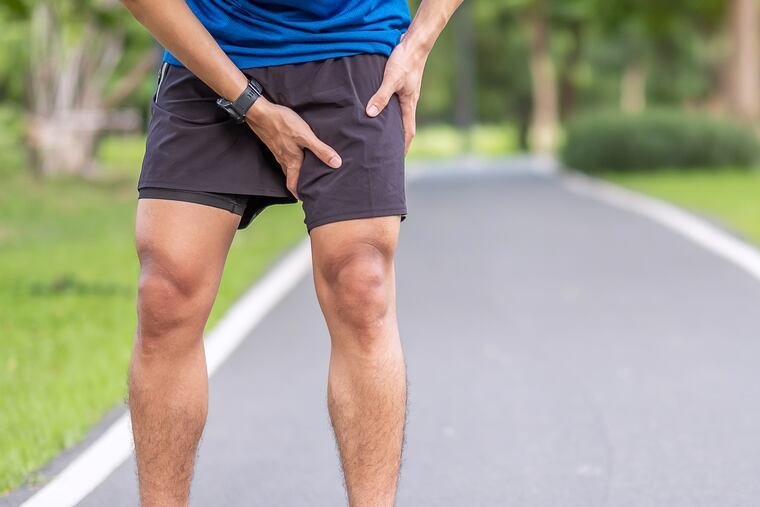Medical Mystery: Young athlete had pain in his groin for months, but no previous injury
Exercise increased his pain and rest temporarily helped it. He had been extremely active and was getting frustrated as this condition was interfering with his ability to play baseball and work out.

Matt is a 29-year-old baseball player as well as former wrestler and weightlifter. He had been having pain in his left groin and upper left abdomen for several months without any injury or previous surgery to those areas. Exercise increased his pain and rest temporarily helped it.
He had been extremely active and was getting frustrated, as this condition was interfering with his ability to play baseball and work out.
He made an appointment with his primary physician, who completed a full workup. He noted that he had no problems eating, drinking, urinating, or passing his bowels, or pain or bleeding during digestion. He had extensive laboratory work, all of which was normal. Searching for any malignancies, he had a thoracic spine X-ray and MRI, which were negative. A chest and rib X-ray also came back normal.
Treatment with a muscle relaxer and steroids was only mildly helpful.
He was then sent to a urologist, who did a testicular ultrasound, also negative. His next referral was to a cardiologist, who did an EKG and stress test, which were negative. His last specialist visit was to a gastroenterologist, who did an ultrasound and CT scan of the abdomen, also normal.
» READ MORE: Medical Mystery: Ongoing knee pain, with no relief from steroid injections
He was then referred to my office. I completed a physical exam and noted pain at his pubic tubercle (a bump on the pubic bone) that transferred down into the adductor muscle (part of the quads) and up into the rectus abdominis muscle (the one that makes a “six pack”). He also had some pain in his upper left abdomen under his left pectoralis (pec) muscle. There were no defects in any of the muscles, nor was there bleeding.
So where was this unusual pain stemming from?
Solution
I ordered an MRI using a special sequence to look at his muscles and their attachments in the groin and the abdomen, putting a special marker in the upper abdomen where he specifically was having pain.
After reviewing the MRI with our head radiologist, we determined that Matt was suffering from a core muscle injury, or what we used to call a “sports hernia.” These injuries occur when the muscles and tendons attached to the pelvic bone are strained or torn. A tear or strain in that area can occur suddenly or evolve more slowly over time.
Matt also had low-grade degeneration of the midline pubic plate, the site of several soft tissue attachments on the pubic bone that links structures of the abdominals and legs. We also discovered an old muscle tear in the left upper rectus abdominis. Both of these findings were probably from old sports injuries that went unrecognized or were not painful enough for Matt to seek medical care.
Matt immediately started physical therapy and is already beginning to feel improvement. He may also consider injection therapy using cortisone in the groin if he does not continue to improve.
» READ MORE: Medical Mystery: A woman’s laborious search for the cause of her searing abdominal pain
This case is an important reminder to continue seeking the right specialist who can help you. In sports medicine, we have changed the name of these injuries from sports hernia to core muscle injury because the two conditions are quite different. A true hernia was looked for by his other physicians, but this turned out not to be any kind of hernia at all.
We see a lot of these injuries especially in sports that heavily use the groin, such as soccer or hockey. We also often see overuse injuries to the bone. Injuries to these areas usually cause pain at the site of the injury; however, the pain may radiate farther into the muscle that is affected.
Activity, such as sports, usually makes these injuries more painful. While we are still learning about types of injuries to the abdomen and pelvis, our physical examination skills and imaging have improved significantly over the last several years, helping to diagnose injuries that may have been missed in the past.
Treatment for core muscle injuries usually begins conservatively with anti-inflammatory medicine, icing, physical therapy and activity modification, as athletes rarely rest these days. If pain continues, injection therapy into the affected area may help. If that fails, we may consider surgery to repair the tear.
The most important thing to remember is if you have pain in the abdomen and/or pelvis, seek medical treatment. There are several diseases and/or medical conditions that require immediate treatment and can be extremely serious if ignored. If a medical reason for your pain is not found, do not rule out a bone, muscle, or tendon problem, especially if you are an athlete. A sports medicine physician can often help you find the cause of the discomfort, whether it is a new or chronic problem, and determine an appropriate treatment plan.
R. Robert Franks is a non-operative sports medicine physician at Rothman Orthopaedic Institute. He specializes in medical orthopedics, sports medicine, and sports-related concussion management.